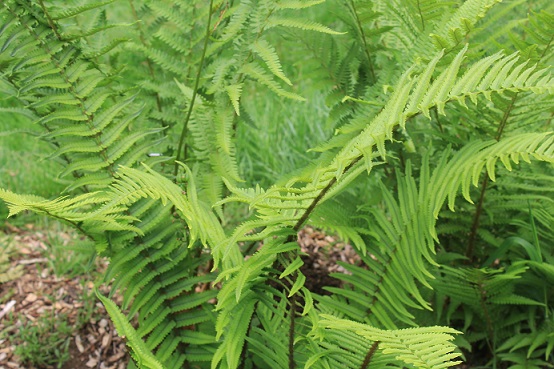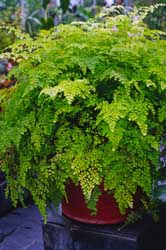STUDY FERNS ONLINE
Learn to propagate ferns (spores, division, tissue culture), different groupings (e.g. epiphytes, ground ferns, tree ferns) and both common & uncommon species. Growing techniques (baskets, indoor/outdoor containers, terrariums) and cultural methods (soils, watering, pest & disease control) are also examined.
- A course for fern enthusiasts or horticultural professionals
- Start any time, study at your own pace and from anywhere!

Lesson Structure
There are 8 lessons in this course:
-
Introduction
-
Review of the system of plant identification, general characteristics of the ferns (especially the fronds), main groups of ferns (filmy, tree, terrestrial, epiphytic and water ferns), information contacts (ie: nurseries, seed, clubs, etc.), pronunciation of plant names.
-
Culture
-
How best to grow ferns and what conditions do they need. Planting, mulching, watering, pest & disease and their control, feeding, pruning, protection from wind, salt air, etc., compost making.
-
Propagation
-
Methods of propagating ferns - spores, division, tissue culture. Propagation of selected varieties.
-
The Most Commonly Grown Varieties.
-
Maidenhairs, tree ferns, stags, elks, common ground ferns.
-
How to grow and propagate these ferns.
-
Other Important Groups.
-
Asplenium, Blechnum, Nephrolepis, Pteris and other groups.
-
Group characteristics, cultural details, propagation methods.
-
Other Varieties
-
Hares foot fern, Bracken, Fans, Corals and Combs.
-
Making the best use of these Plants.
-
In containers, hanging baskets, terrariums, in the ground, as indoor plants
-
Growing and showing, growing for profit (to sell the plants or what they produce).
-
Special Assignment - Detailed culture and identification of one genera.
Aims
-
Distinguish between different types of ferns in cultivation, including twenty different genera and fifty different varieties.
-
Determine critical cultural practices required to successfully grow ferns in different specified situations.
-
Determine the cultural requirements of specific fern varieties.
-
Apply various specialised techniques to the culture of ferns.
-
Prepare a planting plan for an area using ferns.
What You Will Do
-
Label the morphological parts of a typical fern, including:
-
pinnae
-
rachis
-
bipinnatifid fronds
-
lobe
-
midrib
-
crozier
-
roots
-
rhizome.
-
Distinguish species of each type, between aquatic, epiphytic and terrestrial ferns.
-
Distinguish, using illustrations, between different fern families, including;
-
Polypodiaceae
-
Marattiaceae
-
Nephrolepidaceae
-
Cyatheaceae
-
Dicksoniaceae
-
Gleicheniaceae
-
Hymenophyllaceae
-
Compile a resource information guide on ferns, including scope of operation and contact information (ie: address, phone, fax), for:
-
ten nurseries
-
five clubs/societies
-
ten product suppliers
-
other organisations
-
Prepare a collection of fifty ferns, not collected elsewhere, including:
-
a photo, drawing or pressed specimen *plant names (scientific and common)
-
cultural details
-
uses/applications
-
Develop guidelines for growing ferns either indoors, in containers under shade, or in the ground.
-
Label a sequence of four drawings which illustrate the propagation of ferns by spore.
-
List five different fern genera that can be propagated by division.
-
Propagate four fern species, using two different methods, including spores and division.
-
Explain the planting requirements of ferns.
-
List the preferred characteristics of a soil which is to grow ferns in the your locality.
-
Prepare a potting media mix suitable for growing ferns in.
-
Develop guidelines for watering a typical fernery in your locality for a twelve month period.
-
Write a summary of nutrition requirements of ferns, including fertiliser recommendations.
-
Explain five different common health problems of ferns.
-
List guidelines for pruning ferns in your locality.
-
Write a set of guidelines for the culture of a selected fern genus, including details on:
-
distinguishing between different species
-
cultural requirements
-
uses/applications
-
Prepare a table which compares twenty-five different commonly grown fern genera, and includes:
-
plant description
-
preferred habitat
-
growing requirements
-
uses
-
List methods used to propagate fifteen different ferns, including four different propagation methods.
-
Write an essay comparing four species of ferns in the one genera, with reference to physical appearance, growth habit and cultural requirements.
-
Describe endemic growing conditions of five different native ferns sited in natural areas.
-
Prepare a schedule of cultural tasks to be undertaken over a twelve month period which are highly specific to one nominated species of fern.
-
Summarise, a procedure for maintenance over a twelve month period, of a Nephrolepis grown in hanging baskets, including comments on:
-
feeding
-
watering
-
pest control
-
pruning
-
potting up
-
List ten fern species, from at least five different genera, which are particularly suited to growing in hanging baskets in your locality.
-
Compare the suitability of different types of hanging baskets for growing ferns, including:
-
water wells
-
lined wire baskets
-
plastics
-
ceramics
-
Explain how to make a terrarium for growing five different types of ferns.
-
List twenty fern species which grow in very wet conditions, including aquatic plants and bog plants.
-
Distinguish between the cultural requirements of ferns grown indoors and outdoors.
-
Explain the cultural techniques which are unique to growing ferns as an epiphyte. Gow a fern using a specialised technique (eg. in a terrarium or hanging basket), monitoring it over 3 months (ie. recording cultural practices, changes in health, and performance).
-
Write guidelines for preparation of a potted fern for competition in a garden show.
-
Evaluate the use of ferns in a garden, which incorporates both ferns and flowering plants, using a supplied checklist of design criteria.
-
Evaluate the use of ferns in a garden or interior plantscape, which is either all or predominantly ferns, using a supplied checklist of design criteria.
-
Design a fern garden bed of 30 square meters, which incorporates at least ten different fern varieties, and satisfies both aesthetic and cultural requirements of a specified site, which you survey.
As ferns come from a huge range of habitats, it is difficult to set down hard and fast rules on how to best cultivate your ferns.
The easiest way to start is to choose ferns that best suit your climate.
Try to reproduce, as near as possible, the conditions which the plant grows in this natural environment.
If you are more adventurous or have a real fancy for particular ferns that may be hard to grow in your area, you will need to modify the growing conditions to suit. This may be as simple as growing ferns from warm areas indoors in cooler areas or providing additional water to moisture loving ferns being grown in drier areas.
For the really keen grower it may involve the construction of a greenhouse to grow tropical and subtropical ferns or the installation of a comprehensive irrigation system.
While remembering the previous warning about over generalising on growing conditions for ferns there are, however, some general guidelines that can be followed:
- Most need protection from direct sun. Some love shade, but not all types. Semi shade is often ideal.
- Provide protection from direct wind. Hot dry winds will quickly dry out fern fronds. Strong winds will easily damage the fronds.
- Most will grow well in pots, tubs, baskets, or any type of container provided they are kept moist. If fronds dry out, the fronds will not revive (though in some cases the fern will re-shoot from the roots).
- Well drained, but continually moist conditions are generally the rule (waterlogged conditions are only suitable for 'some' varieties).
- The majority of terrestrial ferns prefer soils high in organic matter. The incorporation of well rotted organic matter to your soil prior to planting will usually be beneficial. Sandy soils should be avoided where possible as they are generally low in organic matter and drain
too quickly. Heavy clay or subsoil should be mixed well with coarse sand and organic matter to improve the friability of the soil.
- If grown inside, ventilation is essential!
- Feed only with weak slow release fertilisers. Roots burn easily. Organic based fertilisers, including the seaweed based ones, are ideal.
- Most are propagated by spores, a few are propagated by vegetative means such as division.
- Most ferns will benefit from mulching, particularly when the mulch is composed of well rotted organic matter.
- East or south aspects are preferred with plants planted beside a wall or fence. In hot north or inland areas full shade and frequent watering (several times each day) may be necessary to achieve success with even the hardier varieties.
- Severe frosts can burn unprotected fronds.
WHO IS THIS COURSE FOR?
- Landscapers
- Nurserymen
- Horticulturists
- Environmental Managers and Assessors
- Students of horticulture, plant or environmental science
- Plant collectors, nature lovers, or anyone else with a passion for ferns.
